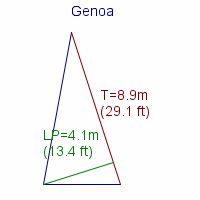Review of Hallberg-Rassy 24 Misil II


Basic specs.

Looking for a new boat? Find a Hallberg-Rassy 24 Misil II or similar boat for sale
Both the hull and the deck is made of fibreglass. Generally, a hull made of fibreglass requires only a minimum of maintenance during the sailing season. And outside the sailing season, just bottom cleaning and perhaps anti-fouling painting once a year - a few hours of work, that's all.
The interior is like many other boats made of mahogany. Mahogany belongs to the hardwood species, known for being water-repellent and resistant to decay. It has an attractive wood grain and holds wood polish and varnish well.
The boat is equipped with 4 berths and a galley.

Unknown keel type
The boat can enter even shallow marinas as the draft is just about 1.20 - 1.30 meter (3.94 - 4.24 ft) dependent on the load. See immersion rate below.
Sailing characteristics
This section covers widely used rules of thumb to describe the sailing characteristics. Please note that even though the calculations are correct, the interpretation of the results might not be valid for extreme boats.
What is Theoretical Maximum Hull Speed?
The theoretical maximal speed of a displacement boat of this length is 6.0 knots. The term "Theoretical Maximum Hull Speed" is widely used even though a boat can sail faster. The term shall be interpreted as above the theoretical speed a great additional power is necessary for a small gain in speed.
The immersion rate is defined as the weight required to sink the boat a certain level.
The immersion rate for Hallberg-Rassy 24 Misil II is about 93 kg/cm, alternatively 522 lbs/inch.
Meaning: if you load 93 kg cargo on the boat then it will sink 1 cm.
Alternatively, if you load 522 lbs cargo on the boat it will sink 1 inch.
Sailing statistics
This section is statistical comparison with similar boats of the same category. The basis of the following statistical computations is our unique database with more than 26,000 different boat types and 350,000 data points.
What is L/B (Length Beam Ratio)?
The l/b ratio for Hallberg-Rassy 24 Misil II is 3.20.
The ballast ratio for Hallberg-Rassy 24 Misil II is 44%.
What is Relative Speed Performance?
The Relative Speed Performance for Hallberg-Rassy 24 Misil II is 34
Maintenance
When buying anti-fouling bottom paint, it's nice to know how much to buy.
The surface of the wet bottom is about 16m2 (172 ft2).
Based on this, your favourite maritime shop can tell you the quantity you need.
Note: If you use a paint roller you will need more paint than if you use a paintbrush.
Dimensions of sail.



Are your sails worn out? You might find your next sail here: Sails for Sale
If you need to renew parts of your running rig and is not quite sure of the dimensions, you may find the estimates computed below useful.
| Usage | Length | Diameter | ||
| Mainsail halyard | 20.6 m | (67.4 feet) | 8 mm | (5/16 inch) |
| Jib/genoa halyard | 20.6 m | (67.4 feet) | 8 mm | (5/16 inch) |
| Spinnaker halyard | 20.6 m | (67.4 feet) | 8 mm | (5/16 inch) |
| Jib sheet | 7.3 m | (24.1 feet) | 10 mm | (3/8 inch) |
| Genoa sheet | 7.3 m | (24.1 feet) | 10 mm | (3/8 inch) |
| Mainsheet | 18.4 m | (60.3 feet) | 10 mm | (3/8 inch) |
| Spinnaker sheet | 16.2 m | (53.1 feet) | 10 mm | (3/8 inch) |
| Cunningham | 2.6 m | (8.5 feet) | 8 mm | (5/16 inch) |
| Kickingstrap | 5.2 m | (17.1 feet) | 8 mm | (5/16 inch) |
| Clew-outhaul | 5.2 m | (17.1 feet) | 8 mm | (5/16 inch) |
This section is reserved boat owner's modifications, improvements, etc. Here you might find (or contribute with) inspiration for your boat.
Do you have changes/improvements you would like to share? Upload a photo and describe what you have done.
We are always looking for new photos. If you can contribute with photos for Hallberg-Rassy 24 Misil II it would be a great help.
If you have any comments to the review, improvement suggestions, or the like, feel free to contact us. Criticism helps us to improve.
